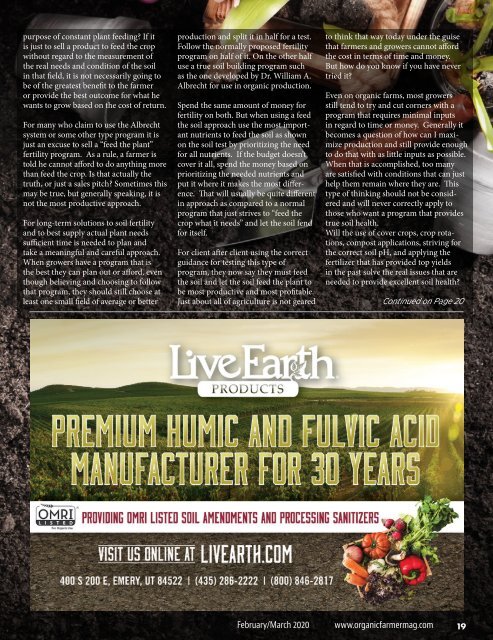Create successful ePaper yourself
Turn your PDF publications into a flip-book with our unique Google optimized e-Paper software.
purpose of constant plant feeding? If it<br />
is just to sell a product to feed the crop<br />
without regard to the measurement of<br />
the real needs and condition of the soil<br />
in that field, it is not necessarily going to<br />
be of the greatest benefit to the farmer<br />
or provide the best outcome for what he<br />
wants to grow based on the cost of return.<br />
For many who claim to use the Albrecht<br />
system or some other type program it is<br />
just an excuse to sell a “feed the plant”<br />
fertility program. As a rule, a farmer is<br />
told he cannot afford to do anything more<br />
than feed the crop. Is that actually the<br />
truth, or just a sales pitch? Sometimes this<br />
may be true, but generally speaking, it is<br />
not the most productive approach.<br />
For long-term solutions to soil fertility<br />
and to best supply actual plant needs<br />
sufficient time is needed to plan and<br />
take a meaningful and careful approach.<br />
When growers have a program that is<br />
the best they can plan out or afford, even<br />
though believing and choosing to follow<br />
that program, they should still choose at<br />
least one small field of average or better<br />
production and split it in half for a test.<br />
Follow the normally proposed fertility<br />
program on half of it. On the other half<br />
use a true soil building program such<br />
as the one developed by Dr. William A.<br />
Albrecht for use in organic production.<br />
Spend the same amount of money for<br />
fertility on both. But when using a feed<br />
the soil approach use the most important<br />
nutrients to feed the soil as shown<br />
on the soil test by prioritizing the need<br />
for all nutrients. If the budget doesn’t<br />
cover it all, spend the money based on<br />
prioritizing the needed nutrients and<br />
put it where it makes the most difference.<br />
That will usually be quite different<br />
in approach as compared to a normal<br />
program that just strives to “feed the<br />
crop what it needs” and let the soil fend<br />
for itself.<br />
For client after client using the correct<br />
guidance for testing this type of<br />
program, they now say they must feed<br />
the soil and let the soil feed the plant to<br />
be most productive and most profitable.<br />
Just about all of agriculture is not geared<br />
to think that way today under the guise<br />
that farmers and growers cannot afford<br />
the cost in terms of time and money.<br />
But how do you know if you have never<br />
tried it?<br />
Even on organic farms, most growers<br />
still tend to try and cut corners with a<br />
program that requires minimal inputs<br />
in regard to time or money. Generally it<br />
becomes a question of how can I maximize<br />
production and still provide enough<br />
to do that with as little inputs as possible.<br />
When that is accomplished, too many<br />
are satisfied with conditions that can just<br />
help them remain where they are. This<br />
type of thinking should not be considered<br />
and will never correctly apply to<br />
those who want a program that provides<br />
true soil health.<br />
Will the use of cover crops, crop rotations,<br />
compost applications, striving for<br />
the correct soil pH, and applying the<br />
fertilizer that has provided top yields<br />
in the past solve the real issues that are<br />
needed to provide excellent soil health?<br />
Continued on Page 20<br />
<strong>February</strong>/<strong>March</strong> <strong>2020</strong><br />
www.organicfarmermag.com<br />
19


















